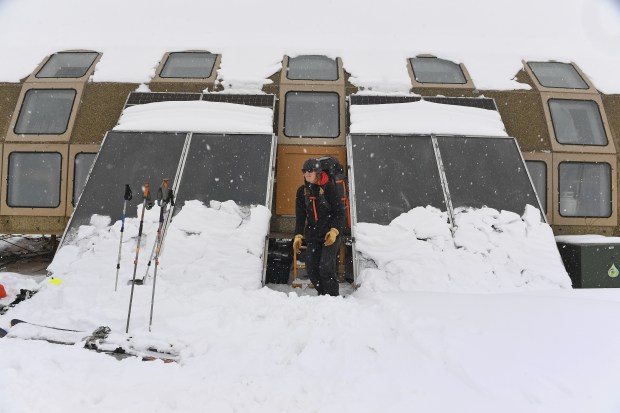NIWOT RIDGE – As federal government-funded scientist Jen Morse skis through blowing snow at 11,500 feet to measure heat-trapping greenhouse gas air pollution, she wrestles with the question that’s been bothering her all week: How humans can know that potentially ruinous climate change is happening yet balk at trying to stop it.
At wind-whipped facilities near the Continental Divide northwest of Nederland, she fills glass flasks with air that shows carbon dioxide concentrations in Earth’s atmosphere as high as 413 parts per million. That figure is still provisional, pending federal review and melding with data from other sites, but reflects a continuing rise above current record levels exceeding 404 ppm — more than 100 ppm higher than at the onset of industrialization — promising more warming, intense storms, droughts, wildfires and other calamities worldwide.
“We understand we are sealing our own fate. We can see it happening,” Morse said, fat, wet snowflakes pelting her face. “And we mostly know how to solve it. We know what is producing emissions and we know what we have to do.”
“Part of it is that everyone is so busy living their lives day to day. And we don’t have a good system in place for solving global problems. This is a global problem,” she said.
Morse and scores of other government-backed scientists are pressing ahead with measuring climate change even as President Donald Trump’s White House moves to dismantle U.S. programs designed to reduce the pollution. Catching air in flasks for the National Oceanic and Atmospheric Administration enables a direct look at the atmospheric buildup of emissions from power plants, vehicles, aircraft, factories and countless other sources worldwide.
Since 1967, scientists at these tundra research facilities have used silvery rooftop receptors to suck air into the flasks and then carried the flasks down to a NOAA lab in Boulder for analysis — amassing perhaps the most precise record of the thickening blanket of greenhouse gases encircling the planet.
They use the University of Colorado’s Mountain Research Station, 35 miles west of Boulder, as their base. They gather air once a week, using skis with climbing skins and aging tracked vehicles to the reach ridge-top collection facilities in winter.
The greenhouse gas measurements from Niwot Ridge are unique because the high-elevation location, touching the lower edge of Earth’s upper atmosphere, tends to give representative readings. Pollution here has mixed with cleaner air and dissipated and, compared with data from about 60 other NOAA sites, typically approximates the overall global average concentrations.
The problem now, scientists say, is that President Trump’s team could move beyond trying to stop U.S. actions aimed at reducing climate change and also kill funding for scientists who document what is happening. Cuts to the Environmental Protection Agency and NOAA budgets proposed two weeks ago targeted basic climate research.
This has caused so much worry that Jim White, director of the CU Institute for Arctic and Alpine Research that helps guide Niwot Ridge research, called an all-hands meeting in Boulder to reassure scientists.
“It was pretty clear when the president’s spokespeople came out and said they don’t think climate change is something we should spend money on,” White said. “We do know this is important — important that we understand what’s in the atmosphere and what’s happening to our planet. It is not something we do because we are trying to annoy people.”
The provisional 413 ppm concentration of CO2 “means CO2 went up in the atmosphere at a very rapid rate last year. It means the amount of carbon dioxide in the atmosphere is accumulating even faster today than it was the year before and the year before,” White said. “If we’re going to turn the corner on greenhouse gases and lower them, one of the first things we have to do is stop the rate of increase. This is like we are speeding up. Eventually we have got to take our foot off the gas pedal.”
Trudging up the mountain each week to collect samples and check instruments measuring precipitation, temperature and various types of pollutants gives Morse, 38, and her colleagues time to reflect.
“It’s heartbreaking. The reality is that certain funding is going to get cut and the emissions will get worse,” said Ryan Webb, 32, a snow hydrologist measuring melting rates to determine how much water will be available in streams and rivers.
The flasks give essential data for gauging future global warming. Morse carefully placed the four she filled last week in soft fabric sleeves and packed them into plastic tubing for protection. Her descent was delayed when a tracked vehicle, built in 1994, broke down. It had replaced a 1965 vehicle. A new, safer tracked vehicle would cost $150,000 – too much for current budgets.
Like others working here, she considers the weekly climbs hauling equipment up a 4-mile trail more of a mission than a job. If worst came to worst, some scientists said they’d still collect samples without getting paid.
“I mean, I don’t need much money to live,” said Morse, who has a 3-year-old son. “Maybe we could launch a Kickstarter campaign? I’ve seen the scientific value these records have.”
It seems “irresponsible” for leaders to deny climate change is happening given the data NOAA provides, she said.
“It is a huge body of research and data collection, you know? There’s this huge network of people working — me up here, the lab techs down in Boulder, the scientists developing the research questions and trying to answer them,” she said. “We’re not all a big hoax.”

Jennifer Morse, a climate technician at the Mountain Research Station (MSR) in Roosevelt National Forest, gets ready to return to her base after checking recent precipitation levels and taking air samples at the Niwot Ridge Long-Term Ecological Research site on March 28, 2017 near Nederland.
